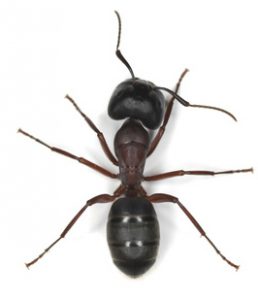Ant (Carpenter Ant)
Binomial Name: Camponotus spp.
Identification:
- Overall Length: Workers are 6-13mm, Queen is 25mm or more

- Colour: Reddish brown or black
- Other Features: Large mandibles, round thorax, single node, cone hairs on tip of abdomen
Life Cycle: A founding queen will establish a colony by laying 20-30 eggs and then feed the larvae until pupation occurs. Workers emerge from these pupae to in turn take care of the queen and excavate a larger colony for her newly laid eggs. Initially, all of the workers are minor workers (workers who care for the eggs, larvae, pupae and the queen) but as the colony matures some of the pupae develop into major workers (workers who defend the colony). The colony will continue to mature for 3-6 years at which time 3000 or more members may be present. The life cycle will take approximately 66 days.
Behaviour: Indoors, carpenter ants make their nests in moist areas or slightly humid places for example, between panelled doors, in wood cabinets near dishwashers, in damp locations behind baseboards, fireplaces, window frames and may also nest in polystyrene insulation, fiberglass and other insulating materials which have not been treated to withstand attack. Carpenter ants usually limit the size of the colony to the area of the damp wood but are capable of doing extensive structural damage.
Outdoors, carpenter ants nest in any wood that is in a state of decay. Wood in close contact to a moisture source, for example, stumps, landscape ties, decks and wooden posts are ideal sites as are the dead limbs or heartwood of trees.
Signs of Infestation: The presence of large, dark coloured ants inside the home is usually the first sign of infestation. Although carpenter ants chew their way through wood, they do not eat it. All material waste or frass (particles resembling sawdust) is ejected through the nest opening so that the nest itself is clean. The presence of frass may indicate ant activity. Colonies within homes can sometimes be located by listening for a rustling sound in walls and ceilings using a stethoscope or inverted water glass to hear the ants.